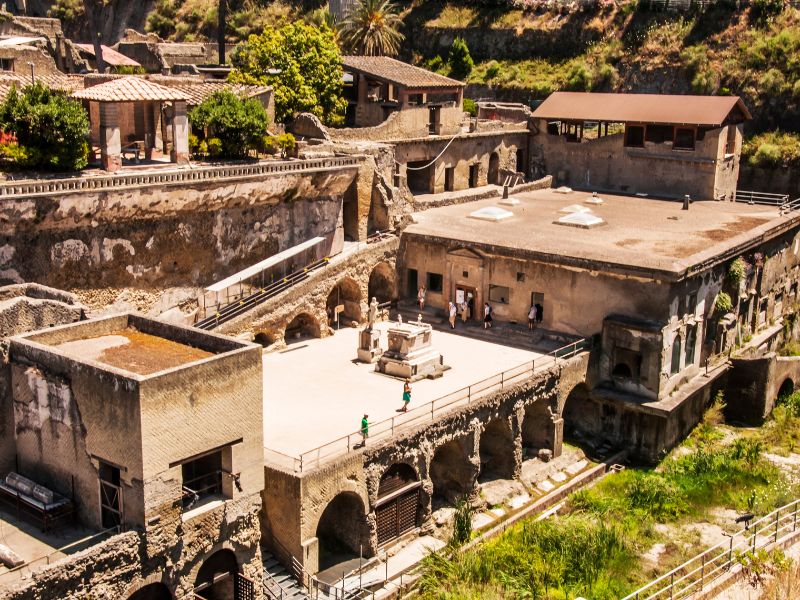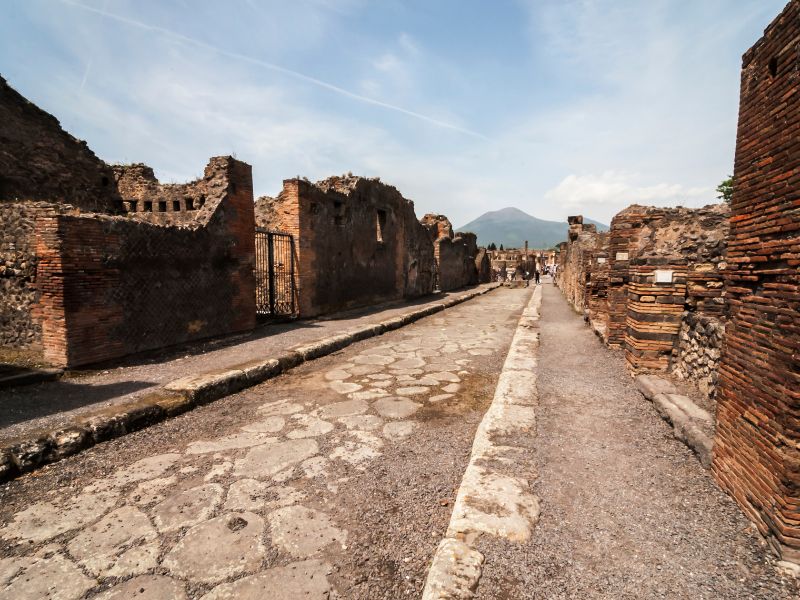Trade in Pompeii and Herculaneum: The evolution of the ancient cities
Table of Contents
Introduction
Trade in Pompeii and Herculaneum was a cornerstone of their economic sustainability and cultural development. Situated strategically near the Bay of Naples, these cities were ideally positioned to become bustling centers of commerce, benefiting from both land and maritime trade routes.
The thriving markets of Pompeii and Herculaneum were replete with a diverse array of goods, including locally produced wine, olive oil, and ceramics, alongside exotic items imported from across the Roman Empire and beyond.
Through trade, these cities not only accumulated wealth but also facilitated significant cultural exchanges, integrating diverse customs and traditions into their daily life. Understanding the intricacies of trade in these cities provides invaluable insights into their societal structures and their role within the broader Roman economy.
The Oscans and the Earliest Settlers

The story of Pompeii and Herculaneum begins with the Oscans, an ancient Italic people who are believed to have settled in the area as early as the 6th century BC. Their presence is evident through archaeological finds, including pottery, inscriptions, and burial sites.
These early settlers laid the groundwork for the urban planning and communal structures that would define the region. The Oscans structured small communities, which evolved into significant settlements, strategically positioned near the Sarno River and the coast, crucial for trade and communication.
The Oscans also contributed to the cultural and spiritual life of Pompeii. Evidence of their influence can be seen in the graffiti and inscriptions found throughout the city, written in the Oscan language.
These provide glimpses into the administrative practices and daily lives of this early society. Their religious practices, focusing on local deities, established a foundation for the spiritual life that would continue to thrive in the city for centuries.
Etruscan Influence in Campania
By the 7th and 6th centuries BC, the Etruscans, known for their sophisticated culture and art, extended their influence into southern Italy, including the cities of Pompeii and Herculaneum. With them, the Etruscans brought advanced architectural techniques and urban planning strategies, which played a significant role in shaping the infrastructure of these burgeoning towns.
The temples, public buildings, and fortifications of Pompeii bear testimony to the Etruscan architectural innovation. In particular, the necropolis of Pompeii reveals the Etruscan approach to burial practices, characterized by non-monumental tombs.
These burials, while simple, housed grave goods like bronze mirrors and jewelry, indicating an elite class presence and reflecting the Etruscan influence in the region. Their legacy in Pompeii is further emphasized by the fortified walls that safeguarded the city from potential invaders.
Greek Colonization and Cultural Exchange
During the 8th century BC, Greek colonists arrived in Campania, bringing with them a wealth of cultural, linguistic, and trade advancements. Although Pompeii and Herculaneum were not directly founded by the Greeks, their influence was profound and long-lasting, evident in the art, religion, and governance of the region.
Greek traders and settlers introduced new artistic styles and religious practices that left an indelible mark on the cities. Greek mythology also left a significant impact on the identity of these cities. According to legend, both Pompeii and Herculaneum were linked to the hero Hercules.
Pompeii’s name is said to originate from the Greek word “pompe,” meaning procession, in honor of Hercules’ victorious path through Italy. Meanwhile, Herculaneum’s connection to Hercules is even more direct, believed to have been founded by the hero himself.
These mythological ties were celebrated through local cults dedicated to Hercules, evident in the Doric Temple in Pompeii and the grand murals depicting the hero in Herculaneum’s public spaces.
The Samnite Occupation and Expansion

In the 5th century BC, the Samnites, a formidable Italic tribe, took control of Pompeii and Herculaneum, ushering in a period of significant transformation. The Samnites contributed to the expansion and reorganization of urban infrastructure, leaving a lasting impact on the cities’ development.
They introduced their own political systems, as illustrated by the Oscan inscriptions documenting local governance and religious practices during their rule. Under Samnite influence, Pompeii grew in size and importance.
While much of the earlier Oscan culture remained intact, the Samnites implemented new building techniques and expanded the city’s commercial potential. This allowed Pompeii to become more prosperous, integrating it into broader Italic networks and enhancing its economic status.
Pompeii’s Strategic Importance: The Role of the River Sarno

Pompeii’s strategic location along the River Sarno was crucial for its development as a thriving trade hub, connecting it to the Bay of Naples and facilitating the transport of goods to and from Campania’s interior.
This advantageous position allowed Pompeii to play a pivotal role in trade between cities like Nola, Nuceria, and Acherrae. Strabo, the ancient geographer, emphasized Pompeii’s significance as a port city, particularly in the trade of commodities such as wine, olive oil, and agricultural produce.
In addition to Pompeii, Herculaneum also benefited from its proximity to the Sarno River, enhancing its trade connections and economic standing. The fertile lands surrounding the river contributed to agricultural success in both cities, helping solidify their status as leading economic centers in the region.
The Development of Pompeii as a Major Trade Hub
By the 4th century BC, trade in Pompeii and Herculaneum had established these cities as significant commercial centers, leveraging their strategic locations at the crossroads of trade routes. The infrastructure evolved to support traders and merchants, with streets filled with warehouses, shops, and bustling markets.
This growth transformed Pompeii into a vibrant economic hub, attracting settlers from diverse cultures and enhancing its cosmopolitan atmosphere. Pompeii’s port on the Sarno facilitated the export of local products, particularly wine, which became renowned throughout the Mediterranean.
Additionally, the city functioned as a distribution point for imported goods such as fine pottery, luxury items, and exotic foods. This thriving trade network further enriched the character of Pompeii and Herculaneum, cementing their roles as crucial links in the ancient world’s commerce chain.
Trade in Pompeii and Herculaneum: A Nexus of Cultural Diversity

Trade in Pompeii and Herculaneum fostered a melting pot of diverse cultures. The presence of Oscans, Etruscans, Greeks, and Samnites created a unique blend of traditions and customs. This diversity is evident in the architecture, art, and religious practices of Pompeii, where Greek temples coexisted with Samnite fortifications, and Oscan inscriptions appeared alongside Etruscan artifacts.
The cities’ cosmopolitan character underscored the importance of trade in promoting cultural exchange and integration. The coexistence of different peoples enriched their histories and set the stage for development under Roman rule, ensuring their continued prosperity as multicultural centers in the ancient world.
Conclusion
The evolution of Pompeii and Herculaneum highlights the role of trade in shaping ancient societies. From Etruscan settlements to thriving trade hubs, influenced by Greek colonization and Samnite occupation, these cities developed rich cultural diversity and economic strength, particularly thanks to Pompeii’s strategic location along the River Sarno.
Their art, architecture, and religious practices reflect a unique identity shaped by centuries of exchange. Today, the legacy of trade in Pompeii and Herculaneum continues to captivate scholars and visitors alike.
